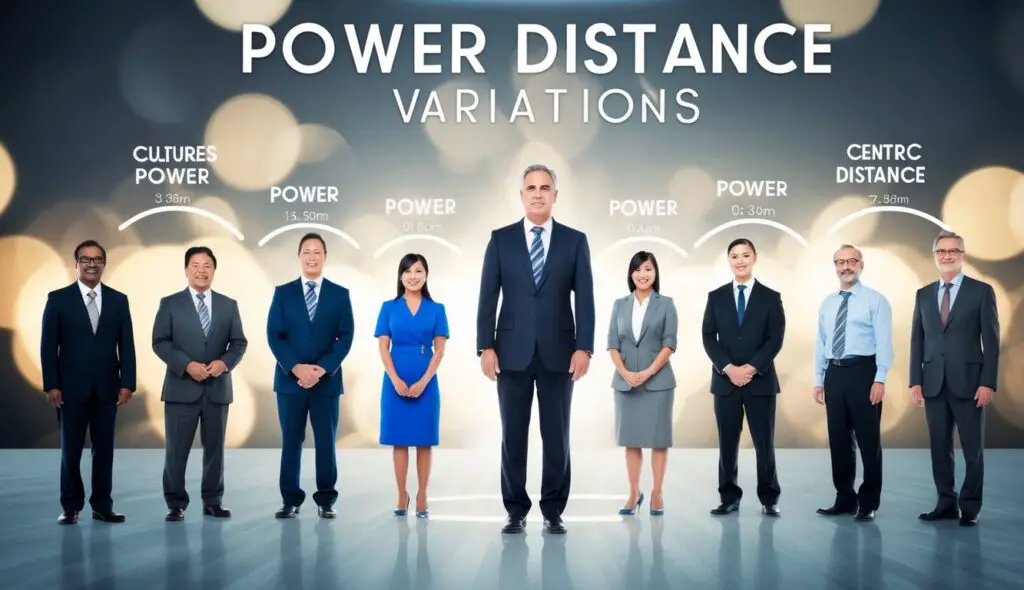Have you ever wondered why some business leaders are treated like royalty, while others are seen as equals? The answer lies in a concept called power distance. This idea shapes how people view authority and impacts leadership across different cultures.

Power distance is a key factor in how leadership works in international business. It affects how decisions are made, how people communicate, and how conflicts are solved. Understanding these differences can help leaders work better with teams from various backgrounds.
Different countries have different levels of power distance. For example, the United States has a low power distance, while some Asian countries have higher power distances.
This means leadership styles that work well in one place might not be effective in another. Good leaders adjust their approach based on these cultural values.
Key Takeaways
- Power distance shapes leadership styles and workplace dynamics across cultures
- Effective leaders adapt their approach based on cultural power distance norms
- Understanding power distance improves communication and decision-making in global business
Fundamentals of Power Distance in Business

Power distance shapes how people view authority and leadership across cultures. It affects workplace relationships and decision-making in global business.
Defining Power Distance and Its Importance
Power distance refers to how much inequality people accept between those with and without power. In business, it influences communication styles and organizational structures.
High power distance cultures tend to have more formal, top-down leadership. Low power distance cultures often have flatter hierarchies and more casual interactions.
Understanding power distance helps leaders adapt their style when working across cultures. It can prevent misunderstandings and improve team dynamics in diverse workplaces.
Geert Hofstede’s Cultural Dimensions Theory
Dutch researcher Geert Hofstede developed the concept of power distance as part of his cultural dimensions theory. His work helps explain differences in how societies function.
Hofstede’s theory includes six dimensions:
- Power Distance
- Individualism vs. Collectivism
- Masculinity vs. Femininity
- Uncertainty Avoidance
- Long-Term vs. Short-Term Orientation
- Indulgence vs. Restraint
These dimensions offer a framework for comparing cultures. They provide insights into workplace values and behaviors across countries.
Power Distance Index (PDI) Explained
The Power Distance Index (PDI) measures the level of power distance in a society. It uses a scale from 0 to 100, with higher scores indicating greater power distance.
Countries with high PDI scores tend to have:
- Strict hierarchies
- Centralized decision-making
- Less accessible leaders
Low PDI countries often feature:
- Flatter organizations
- More participative management
- Greater equality between levels
The PDI helps businesses tailor their approaches to different markets. It guides choices in leadership style, organizational structure, and communication methods.
Analyzing Power Distance Variations Across Cultures

Power distance differs greatly between countries and impacts how people interact in business settings. These differences shape leadership styles, communication, and decision-making processes.
High Versus Low Power Distance Cultures
High power distance cultures accept large inequalities in power and status. Leaders in these cultures often make decisions without input from subordinates. Employees rarely question or disagree with bosses.
Low power distance cultures value equality more. Leaders ask for employee input and encourage open communication. Staff feel comfortable voicing opinions to managers.
Examples of high power distance countries include Malaysia, China, and Mexico. Low power distance countries include Denmark, Israel, and Austria.
Case Studies: United States and Other Countries
The United States has a relatively low power distance score. American workplaces tend to be less formal. Employees often call bosses by first names. Open-plan offices are common.
In contrast, Japan has higher power distance. Japanese companies use more formal language and have clearer hierarchies. Workers show great respect to senior staff.
France falls between the U.S. and Japan. French companies mix formality with some openness. Titles are important, but dialogue between levels is accepted.
Impact of Cultural Differences on International Business
Power distance affects many aspects of international business. It shapes hiring practices, teamwork, and leadership styles.
In high power distance cultures, decisions often come from the top. Employees expect clear instructions. Managers may need to adapt their style when working with staff from different backgrounds.
Low power distance cultures value initiative. Workers may struggle in settings where they can’t share ideas freely. Companies must bridge these gaps for effective global operations.
Leadership and Decision-Making in Diverse Power Distances

Power distance shapes how leaders interact with employees and make decisions across cultures. It affects organizational structures and the role of authority figures.
Adapting Leadership Styles to Power Structures
In high power distance cultures, leaders often take a more authoritative approach. They give direct orders and expect compliance. Employees look to leaders for clear direction.
Low power distance cultures favor a more collaborative style. Leaders act as coaches or facilitators. They seek input from team members and encourage open dialogue.
Effective global leaders adjust their style based on local norms. In Japan, a top-down approach may work well. In Denmark, a flatter structure is typical.
Leaders should be aware of their own cultural biases. Training in cultural intelligence can help them adapt.
Decision-Making in Hierarchical vs. Egalitarian Settings
Hierarchical cultures centralize decision-making at the top. Senior executives make most key choices. Lower-level staff have limited input.
Egalitarian settings spread decision power more evenly. Teams may use consensus-building or voting. Employees at all levels can influence outcomes.
Decision speed varies between these models. Hierarchies can act quickly but may miss diverse viewpoints. Egalitarian processes take longer but can lead to better buy-in.
Leaders need to balance efficiency and inclusivity. They should consider:
- The urgency of the decision
- The expertise needed
- The impact on different stakeholders
Authority Figures and their Role in Organizational Culture
In high power distance cultures, authority figures hold significant sway. They shape company values and norms. Employees often defer to their judgment.
Low power distance cultures view authority more loosely. Leaders are seen as experienced colleagues rather than unquestionable experts.
The role of authority impacts:
- Communication styles
- Feedback processes
- Innovation and risk-taking
Power distance influences leadership dynamics across the organization. It affects how people interact, share ideas, and solve problems.
Leaders must navigate these cultural expectations. They should build trust and respect while fostering an environment that fits the local context.
Effective Communication and Conflict Resolution Strategies
Power distance affects how people communicate and handle conflicts in international business. Leaders must adapt their approach to bridge cultural gaps and foster understanding. This requires developing specific skills and strategies.
Cross-Cultural Communication and Management
Cultural differences can lead to misunderstandings in global teams. Leaders need to recognize and adapt to varying communication styles.
In high power distance cultures, communication tends to be more formal and hierarchical. Low power distance cultures often prefer direct, open dialogue.
To manage effectively across cultures:
• Learn about cultural norms and expectations
• Adjust communication style to fit the context
• Use clear, simple language to avoid confusion
• Provide opportunities for feedback and questions
Managers should also be aware of non-verbal cues. Gestures, eye contact, and personal space can have different meanings across cultures.
Fostering Open Communication in High Power Distance Environments
High power distance cultures may discourage employees from speaking up. Leaders can create a more open environment by:
- Encouraging participation in meetings
- Soliciting ideas from all levels of the organization
- Implementing anonymous feedback systems
It’s important to build trust gradually. Start with small group discussions before moving to larger forums. Recognize and reward those who contribute ideas.
Leaders should also model open communication. Share information transparently and admit mistakes. This helps create a psychologically safe space for others to voice their thoughts.
Cultural Intelligence and Sensitivity in Resolving Conflicts
Cultural intelligence is crucial for resolving conflicts in diverse teams. Leaders must understand how cultural backgrounds influence conflict styles.
Some cultures prefer direct confrontation, while others value harmony and indirect approaches.
To resolve conflicts sensitively:
• Listen actively to all parties involved
• Recognize cultural biases in your own approach
• Find common ground and shared goals
• Use neutral language to avoid escalation
Mediation can be effective in cross-cultural conflicts. A neutral third party can help bridge cultural gaps and facilitate understanding. Training programs on cultural sensitivity can also help prevent conflicts before they arise.
Frequently Asked Questions
Power distance impacts many aspects of international business leadership. It affects how teams interact, make decisions, and negotiate across cultures. Let’s explore some key questions about power distance in global organizations.
How does power distance impact leadership styles in multinational companies?
Power distance influences leadership approaches in multinational firms. In high power distance cultures, leaders often use more directive styles. They may give specific instructions and expect compliance.
Low power distance cultures tend to favor participative leadership. Managers involve employees in decisions and encourage open communication.
What strategies are effective for managing teams with differing perceptions of power distance?
Effective leaders adapt their style to match team expectations. They learn about cultural norms and adjust accordingly.
Clear communication about roles and responsibilities helps. Setting ground rules for interaction can bridge cultural gaps.
Can you outline the correlation between power distance and employee behavior in global organizations?
In high power distance settings, employees may be less likely to question authority. They often wait for directions before taking action.
Low power distance cultures see more employee initiative. Workers feel empowered to share ideas and take risks.
What role does power distance play in shaping organizational culture across different countries?
Power distance affects many aspects of company culture. It influences communication patterns, decision-making processes, and hierarchical structures.
High power distance cultures may have more formal workplace interactions. Low power distance environments often foster more casual, open atmospheres.
How does high power distance influence decision-making processes within international firms?
In high power distance contexts, top leaders often make decisions alone. Lower-level employees may not be consulted.
This can lead to faster decisions but may miss valuable input from staff. It can also create challenges in implementing changes.
What are the implications of power distance on international business negotiations?
Power distance impacts negotiation styles. In high power distance cultures, senior executives may expect special treatment.
Low power distance negotiators might focus more on facts and mutual benefits. Understanding these differences helps avoid misunderstandings during talks.

